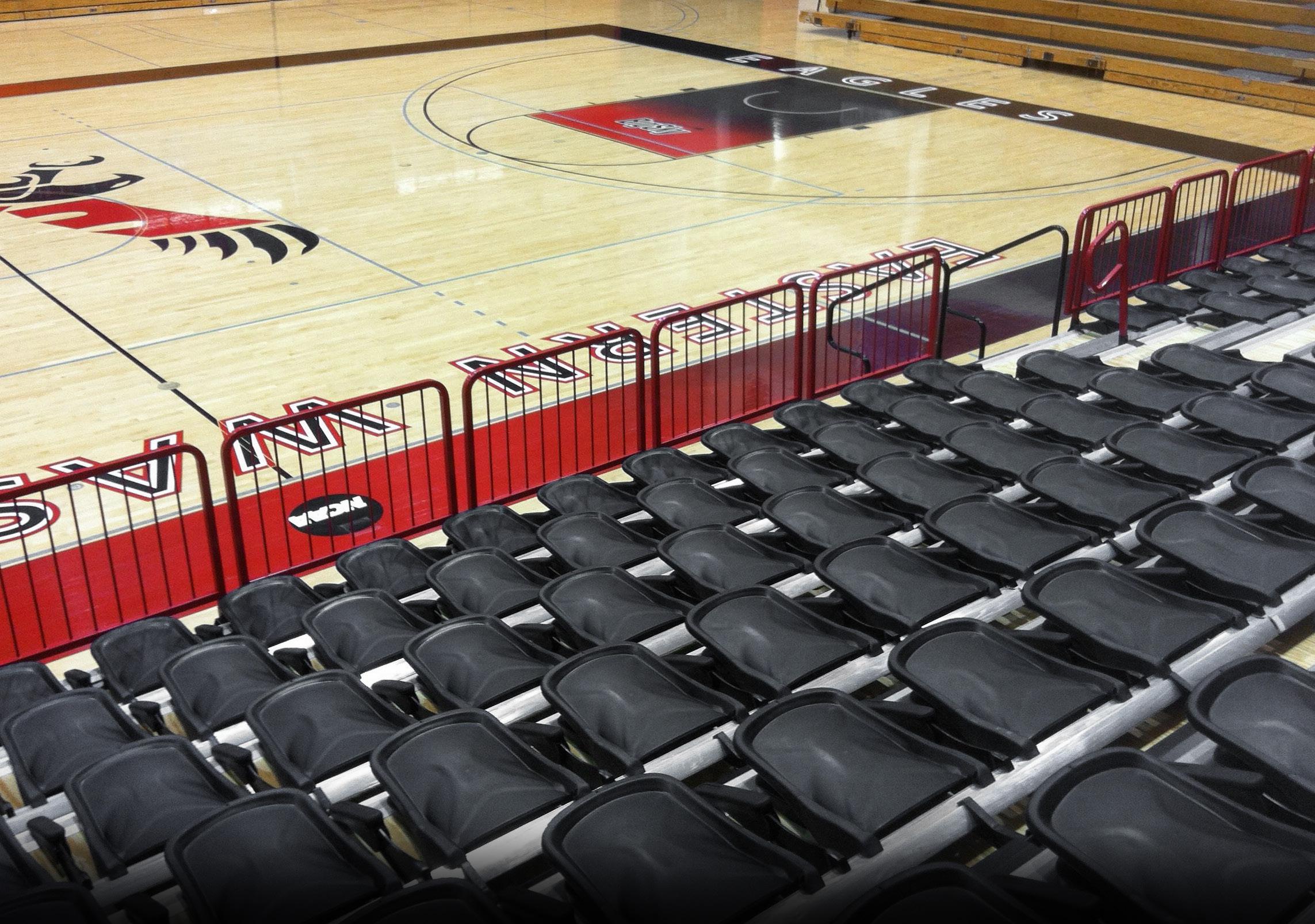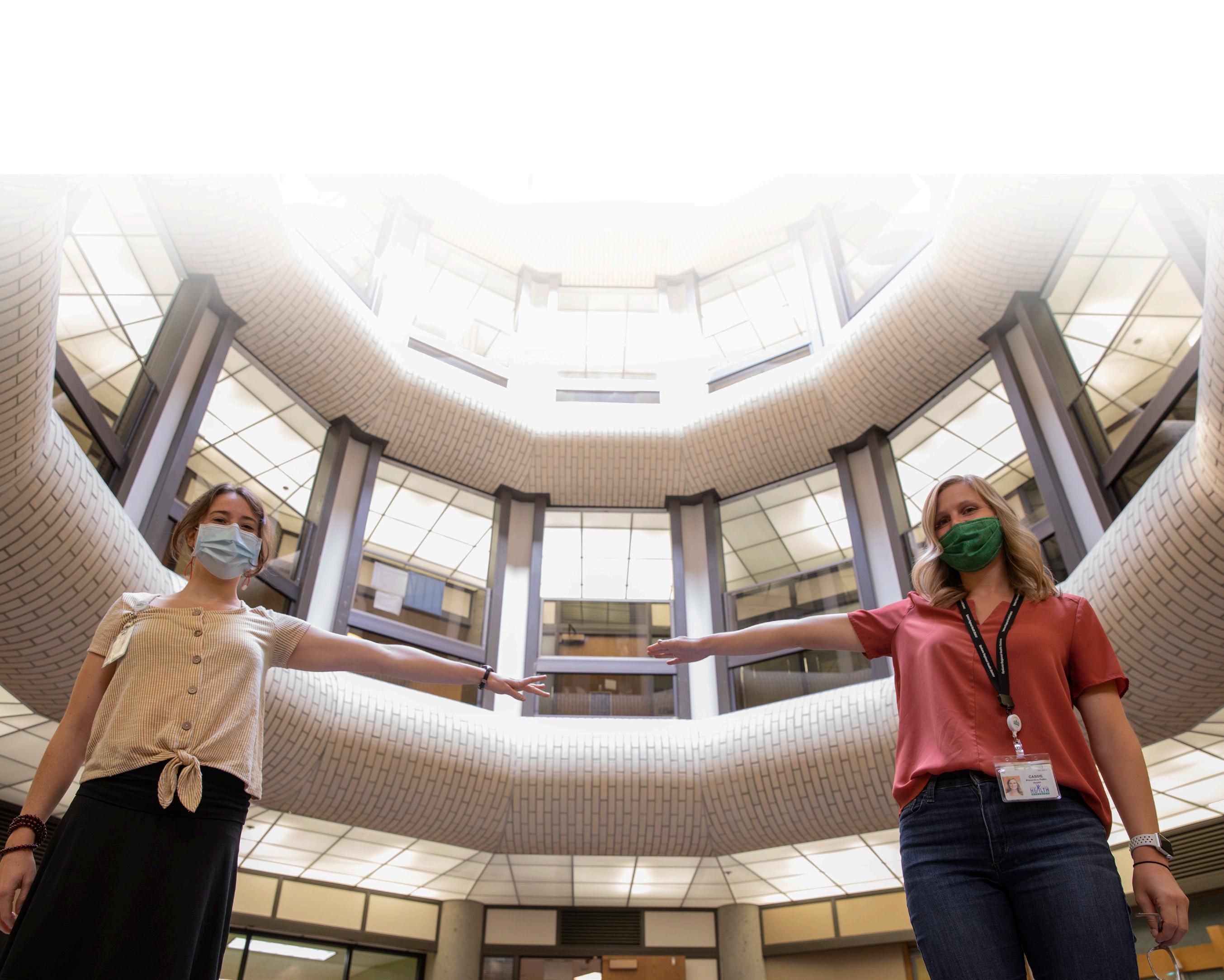
17 minute read
Health Heroes
EASTERN GRADUATES ARE AT THE HEART OF SPOKANE’S CORONAVIRUS RESPONSE
By Charles E. Reineke | Photos by Eric Galey
It is not glamorous work. The days are long, often exhausting: there are phone calls, data analyses, site visits, isolation interventions, testing, more testing, and messaging that urges, sometimes pleads, with residents to “wash your hands, maintain social distance, Inland Northwest. In the coming months they will almost certainly save many more. At the Spokane Regional Health wear masks, stay home when you’re ill.” Their labors are mostly behind the scenes, thankless. District, the agency at the center of When the workday ends, no one hangs out of apartment windows cheering their efforts. Spokane County’s full court press against COVID-19, graduates from
But make no mistake, the local public health professionals who Eastern Washington University are prominent among those keeping us perform these tasks — those crucial foot soldiers in the battle to beat back safe. Eastern magazine spoke with several Eagle alumni to learn how they’ve the most deadly viral pandemic in a century — are heroes just the same. contributed — and how they’re coping — during this time of unprecedented Their work has already saved dozens, if not hundreds of lives here in the threat to our health and wellbeing.
Kira Lewis

One of the newest Eagles at the health district is Kira Lewis ’20, a public health nurse who balanced her lengthy work days with study for Eastern’s Master of Public Health program. Lewis was just a quarter away from graduation when the pandemic hit, but managed to complete her classes anyway. She says she was so busy that she barely registered the fact that Eastern’s semester graduation ceremony, scheduled early May, had been suspended due to the virus.
“The last bit of school happened amid very long work weeks and the craziness of Covid,” says Lewis, who completed her MPH while working as a public health nurse at the health district. “Finishing this semester was rough. Many of my coworkers knew that I was aching for the end, so they threw me a little surprise graduation event at work.”
Seldom has a party been more deserved. Lewis is among a handful of public health nurses who work directly with some of Spokane County’s most vulnerable people — the poor, the homeless, the drug and alcohol dependent, and others on society’s margins.
Keeping these populations healthy is never easy, but Covid ratcheted up the challenge. As the pandemic began its rampage across the region there were real concerns that individuals in these groups — many of whom suffer from a range of chronic health conditions — would be devastated by the illness. That this hasn’t happened is a testament to the dedication and courage of professionals such as Lewis.
“I have been, and will continue to must constantly be around people with COVID-19,” she says. “But I use PPE and follow adapt, sometimes by the established protocols and process the hour, to keep up that keep me and the people I’m with all things Covid. helping as safe as possible. This is part of being a nurse.”
Cassie Prather
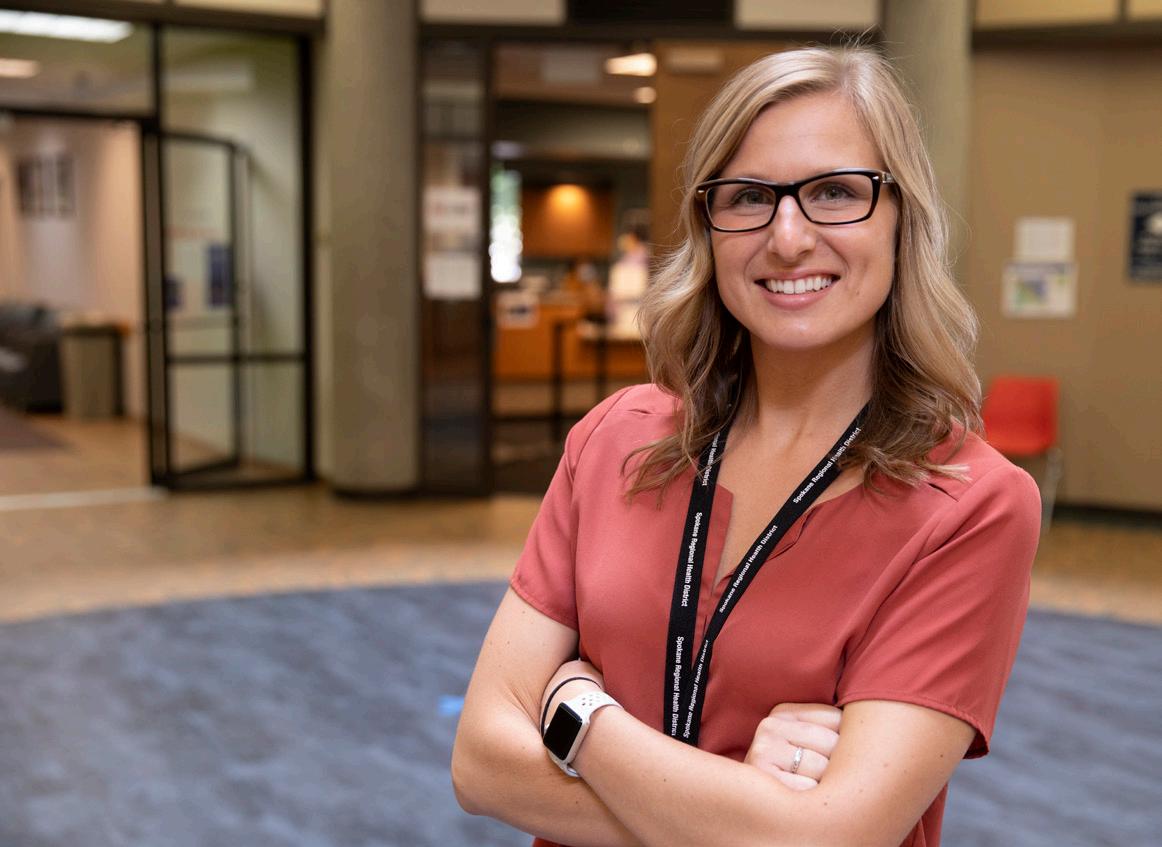
When Cassie Prather ’17, ’19 first arrived at EWU, she thought she wanted to be a nurse, too. But soon the life-long Spokane resident shifted gears into health policy and later, as a graduate student, into the field that now defines her working life: epidemiology.
“I took an epidemiology class my senior year at EWU, and instantly knew that is what I wanted to do,” Prather says, pointing to Anna Tresidder, former program director of Eastern’s MPH program, and Pamela Kohlmeier, a physician and public health lecturer at EWU, as being particularly influential.
Prather joined the health district just as the pandemic was taking hold, and immediately became a key part of the agency’s all-hands-on-deck COVID-19 response. As one of five permanent epidemiologists, she is on the front lines of the battle.
The detective-like work of epidemiologists involves identifying people who have been infected with the virus, their close contacts, and others who may be at risk. For Prather, her job also includes controlling the virus’ spread in locations that are especially vulnerable, places such as long-term health facilities, group houses and factories.
So far, she says, it has been an exhausting but rewarding experience.
Katie Booher
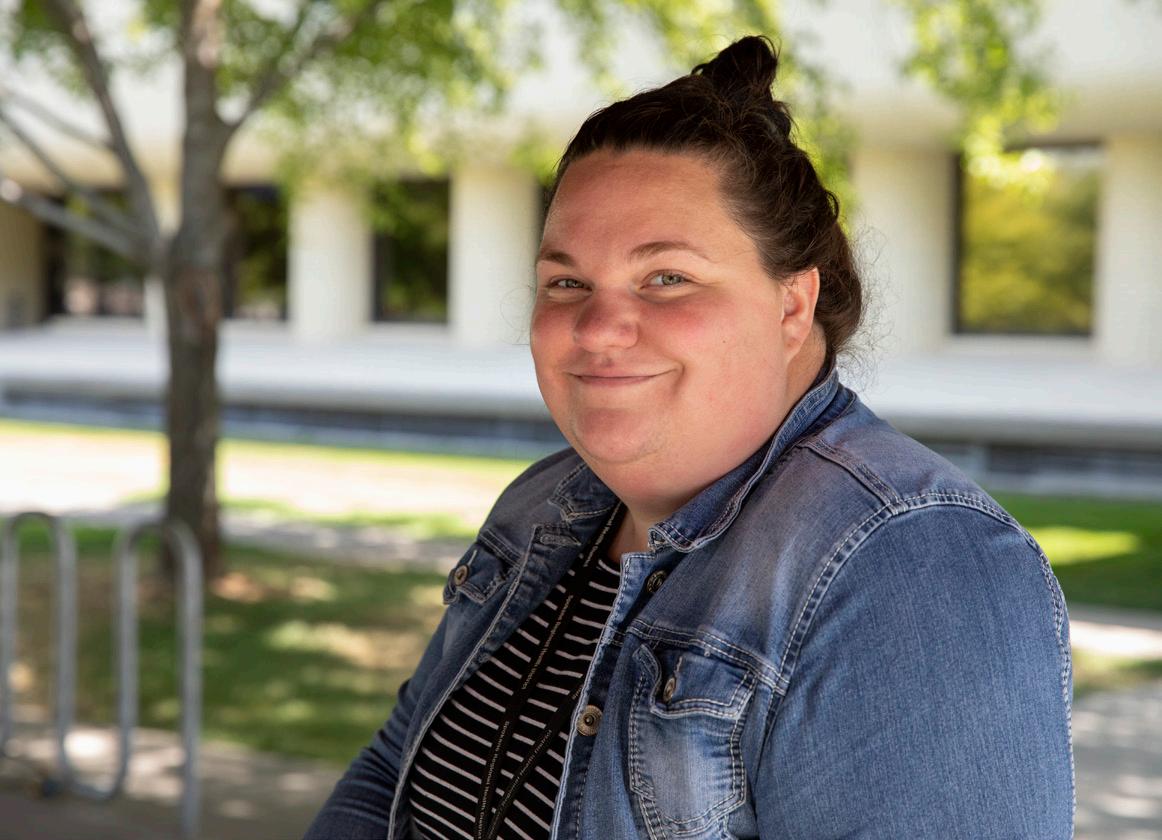
Katie Booher ’14, ’16 also earned both bachelor’s and master’s degrees from EWU. Her master’s degree in public health, with its focus on disease prevention, ensured that, like Lewis, she too was well placed to help some of our region’s most vulnerable.
Before the pandemic she led the health Province, which reminded me of the last scene in the district’s effort to limit the spread of HIV and movie ‘Contagion.’” other sexually transmitted diseases, with a focus Rose says she wasn’t seriously thinking the outbreak on coordinating disease-prevention activities at would result in anything resembling a Hollywood the Syringe Services Program — a walk-in facility more colloquially known thriller. Yet it wasn’t long before she realized that the virus would not be as the “needle exchange.”
“Because of the pandemic,” Booher says, “a lot of our staff was pulled to work on case investigation and other tasks related to COVID-19. This left a lot of daily tasks with little to no staff.”
The pandemic, of course, did not end the transmission of STDs, nor the need to alert those who may have been exposed. So Booher stepped in to take on much of the STD reporting burden, while at the same time drawing up plans to adapt the needle exchange to post-Covid realties — including supply chain interruptions that created serious shortages of sanitizing gear.
“I created a plan for our Syringe Services Program in response to the Health District and CDC guidelines,” she says. “This included creating distance in a very small service area, scheduling volunteers and staff for temperature taking, and enforcing mask wearing with clients, when applicable.” She also streamlined the normal syringe-service process to get clients in and out more quickly. What used to take as long as 10 minutes, she says, now can be done in as little as one minute. And, after months of shortages and uncertainty, the program now is again receiving the supplies it needs to keep clients safe.
Through it all, Booher says she has remained confident that she and her colleagues will remain on top of things. She admits, however, that she sometimes wishes the wider world were just a bit more appreciative. “Public health rocks,” she says.
Summer Rose
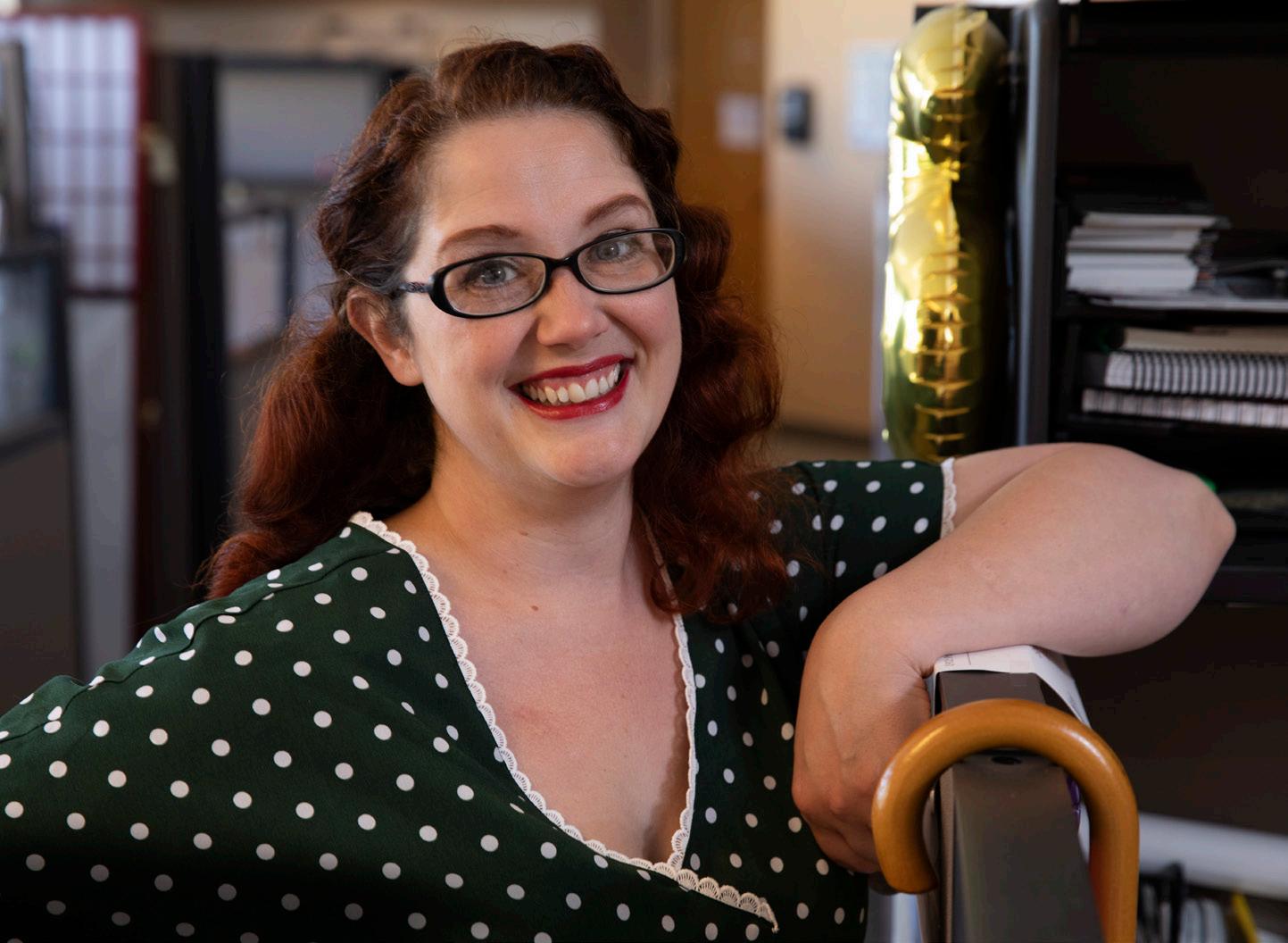
Expecting the unexpected is all in a day’s work for the health district’s Summer Rose ’13, ’18, an emergency-preparedness planner. Rose, who earned both a bachelor’s degree in exercise science and a master’s degree in public health from EWU, says she first heard about the outbreak of a novel coronavirus just before Christmas.
“I remember getting the CDC notification on Dec. 21,” Rose says. “Receiving those notifications is nothing unusual for those of us who work in disease prevention and response, but I remember that particular one because it mentioned the marketplace in Huang Province, which reminded me of the last scene in the movie ‘Contagion.’”
Rose says she wasn’t seriously thinking the outbreak would result in anything resembling a Hollywood thriller. Yet it wasn’t long before she realized that the virus would not be contained in China, and that the whole world had better get ready. “By the time we all returned to work after the holidays, it was already becoming clear that we needed to prepare,” she says.
When COVID-19 arrived on our shores, Rose was serving as the planning section chief on the health district’s Incident Management Team, the group charged with responding to serious public health threats.
She also served as the health districts point person for the joint Emergency Operations Center — the multi-agency group that helps the city and county deal with disasters.
“As our team at the health district joined with the city and the county at the Emergency Operations Center, it quickly became very clear that we would need more manpower in key incident management positions,” she says. “We pulled staff from all over the health district. I was amazed and impressed with how our staff preformed and collaborated with our partners in a very high pressure, high-stress environment.”
“Our staff members that went to the EOC with me were extraordinary,” she adds. “We were working with politicians, city workers, emergency management, fire, police, military, the department of corrections, local non-profits, community organizations, and others. They stepped into the emergency response world — not an easy thing to do — and they proved to be these amazing partners, leaders and collaborators.”
Rose is currently spending most of her time ensuring that the health district’s isolation site — a place where Covid-positive patients without the means to self-isolate can convalesce — has everything it needs to safely quarantine patients. She says work at the isolation site, like her planning efforts, have reinforced the encouragement she received from mentors at Eastern who said a career in public health, though sometimes underappreciated, makes a real difference.
“There are days, times in all of our lives, that we will always remember: where we were, what we did, how we felt,” Rose says. “As challenging and physically exhausting as the last six months have been — and the next six months likely will be — I have been humbled and honored to have seen the things I have seen: the creativity people have shown; the collaborations between groups who are rarely called upon to work together; the kindness of people, even when they know they will not get any recognition for it.”
Tiffany Turner
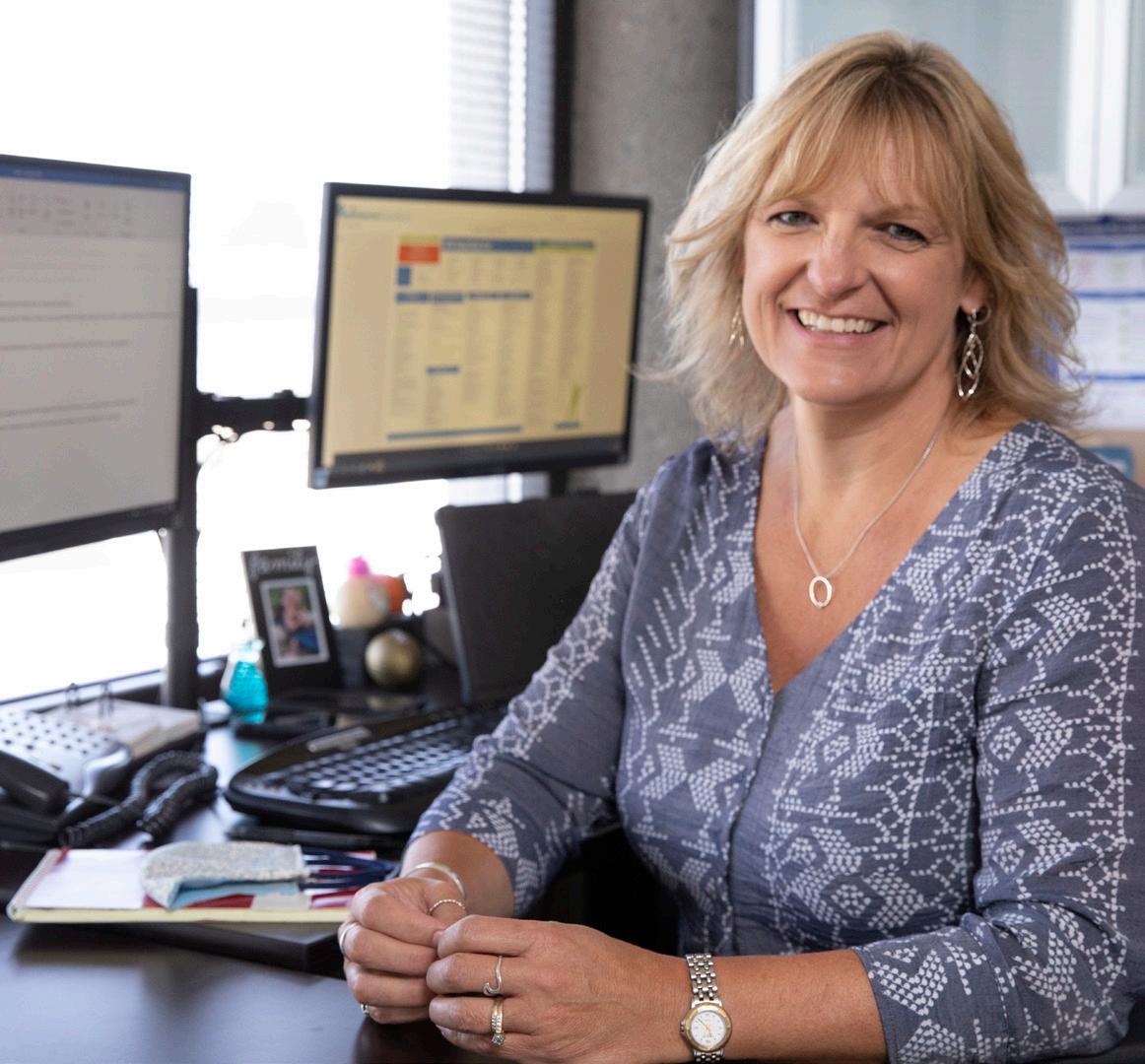
As Rose’s experience shows, a successful campaign against a threat on the level of COVID-19 can only succeed when everyone knows their role and feels empowered to accomplish it. For close to 20 years, the health district’s Tiffany Turner ’96, an EWU community health graduate, has been leading efforts to ensure that we were prepared for the worst.
Serving as the program manager for SRHD’s Emergency Preparedness and Response Program, she’d planned, modeled and table-topped pretty much every potential catastrophe under the sun. And the cataclysm came.
“We spent a lot of time developing plans, training and practicing to respond to various hazards,” Turner says. “Now it was show time!”
During the pandemic she was named the health district’s liaison officer at the county Emergency Operations Center, where, like Rose, she works with local, regional, state, and federal partners to coordinate efforts and share information. Years of developing relationships with such groups was crucial to Spokane’s successful Covid crisis response.
“I’m extremely proud of how our agency staff willingly stepped up to take on new roles and responsibilities, and how our community partners offered to assist public health in whatever capacity they could,” Turner says. “Although each program and agency have their own plans and processes, we came together as one to take care of our community.”
Since the pandemic began, experts have pointed to widespread community testing as the key to containing it. Only by knowing who has the disease, in other words, can public health professionals effectively quarantine the ill and isolate their virus-exposed close contacts.
Kari Lidbeck
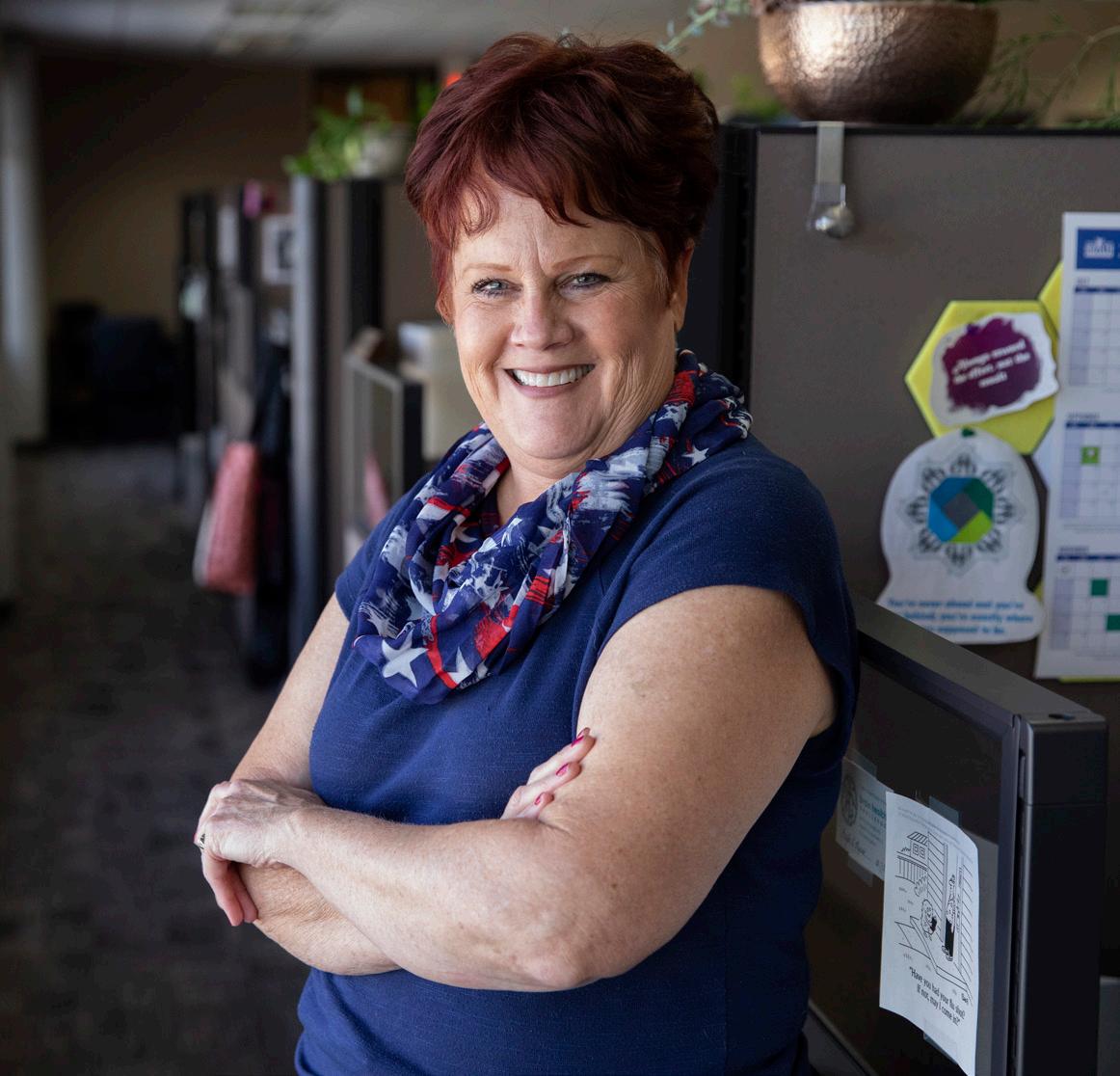
For Kari Lidbeck ’93, a life-long resident of Spokane who graduated from Eastern with a degree in community health education, helping out with testing came naturally.
In the years following her graduation, she built a career working in health administration, compliance, quality improvement and electronic medical records; experiences that led her, pre-pandemic, to a job with the health district’s Immunization Assessment & Promotion Program. That position, Lidbeck says, was focused on helping to move the dial on immunization rates for children under the age of 6, including setting up mobile vaccination clinics. When the pandemic hit and the desperate rush to testbegan, she was uniquely positioned to help.
“Once we were in the COVID-19 emergency response, my role was to supervise task forces responsible for setting up community testing sites,” she says, along with the isolation facility and an alternate-care facility for those with the illness. “As of today,” she says, “I am still the lead on community testing.”
In that role, Lidbeck has been instrumental in again moving the dial, this time toward containing the virus. “We have made it possible for thousands of people to get tested for COVID-19,” she says.
But testing, she adds, is not enough: Communication is critical. Just as some, out of ignorance or fear, resist vaccinating their children, so do we face a limited but potentially damaging backlash against a science-based approach to combatting the pandemic.
“Some people think that a vaccine is the answer,” Lidbeck says.
"I also hear from people that they do not trust the messaging that is coming from the Department of Health and other government agencies.”
There has also been Covid-related fallout for routine childhood vaccinations, she adds. “We are currently seeing a huge decline in vaccination rates for children because of the shutdown. My program is looking at offering curbside vaccinations to reduce barriers for parents — we will definitely be ramping up efforts to vaccinate against influenza this season.”
Those concerns aside, Lidbeck, like the rest of her colleagues, has been gratified that so many have joined together to accomplish so much. “I have been pleasantly surprised at the ability for disparate groups of people to come together for a common purpose, to get ‘stuff done,’” she says.
Elena Mierau

Elena Mierau ’09, is a die-hard Eagles fan who met her husband at EWU and never misses a home football game. For her, getting stuff done meant an abrupt shift in her working life.
Mierau, with a bachelor’s degree in community health from Eastern and a master’s degree in public health from Des Moines University, coordinates active transportation programs for the health district, chiefly two programs that encourage Spokane residents to make their commute more “active.” The Walking School Bus supports and accompanies elementary school students on their safe walk to school, and Walk Bike Bus supports adults in walking, biking and busing in their community.
When the schools closed, Mierau shifted to COVID-19 response. Because she had previously worked with the Regional Emergency and Disaster Healthcare Coalition, or REDi, she returned there to support member hospitals looking to better communicate their ongoing capacity needs. After a few weeks, she found herself moving to the coalition’s operations center, helping to get coronavirus patients to other facilities when maxed-out hospitals could no longer care for them.
“When COVID-19 began to ramp up,” she recalls, “it was all hands on deck. Many people were put far outside of their comfort zones and started new jobs that they had never intended to work in. Other staff began workingseven days a week, lots of overtime, with very little rest. Everyone laid aside their needs to support the community.”
We will need to maintain that community spirit, she adds, even after we eventually get a handle on the pandemic.
“Of course cases need to decrease so we can get children back to school, and businesses can feel comfortable reopening,” Mierau says. “But after the disease is under control, our long-term battle must involve raising awareness [about] social factors that influence health. This disease is disproportionately effecting people of color. We need to create an equitable society were all people have the opportunity to live in safe housing, have access to healthy food, exercise and clean air.”
Jackie Post

Protecting and promoting the health of diverse populations is a key part of what Jackie Post ’06 does every day. Post earned a bachelor’s degree from Eastern with a double major in both visual and technical communications. She says that after her graduation she was determined not to limit herself to any particular field or discipline, but did hope to one day write about science and health-related topics.
That ambition was fulfilled when she joined the health district as a health communications specialist two years ago. Health communications is defined by the CDC as creating solutions that “deliver health information and interventions using customer-centered and science-based strategies.” Seldom has such work been so important. “Since the pandemic,” Post says, “my day-to-day tasks have focused almost exclusively on communications related to COVID-19.”
In public health, she adds, it’s common to shift gears to accommodate the particulars of a response. One month, for example, she might need to ramp up efforts to address poor air quality caused by wildfire smoke. The next month, it might be an emerging health issue such as the recent spate of vaping-related lung illnesses.
“However, the all-consuming nature of the pandemic response has been unique,” Post says. “Every communications project now must take COVID-19 into consideration, regardless of the topic.”
Among the most high-profile of these projects for Post has been her work with the health district’s “case information and data visualization page,” a critical resource for policy makers, health-care workers and journalists who need constantly updated information on the crisis.
“There are a lot of components that go into reporting COVID-19 case data, and it requires collaboration,” she says. “Taking part in that, working with our talented staff, and gaining a better appreciation for the statewide case-reporting process has been fascinating.”
Post says the work has cast into stark relief the critical role public health plays in society, and that no era is immune to unexpected challenges. Her initial training at the health district, she recalls, included a history section with the 1918 influenza pandemic as a major topic. “I remember wondering what it would have been like to live through,” she says. “Now, we all have a better understanding of what it might have been like.”
A big advantage today’s public-health pros have over their 1918 counterparts is access to vast troves of data — information that allows them to better target responses, allocate resources and anticipate problems.
Hannah Cylkowski

Hannah Cylkowski ’15 is in the business of managing all of that information. At Eastern, she studied health services administration and
health science, where, she recalls, German Izon, an associate professor of economics, had a big impact. “He taught me there was no easy way, you have to learn to grow, and to believe in myself,” Cylkowski says. “He also helped me change my narrative about ‘being bad at math,’ and that had a lasting impact.”
Prior to the pandemic, she deployed her math skills as the REDi Healthcare Coalition information management coordinator for 19 counties and four tribes in Eastern Washington. Much of that coordination happened via WATrac; an online communication system used by health care agencies to coordinate activities and prepare for emergency events. WATrac is still a fundamental part of COVID-19 response, Cylkowski says, and since the pandemic’s onset she has taken on the role of operations section chief for the healthcare coalition’s response.
Such efforts, along with the community partners that have worked to tamp down transmission and treat those infected, have thus far kept the region from lapsing into a New York-style capacity crisis. But she’s not getting complacent.
“We’ll see challenges in staffing both from the public health side and in the healthcare setting,” Cylkowski says, adding that the risk of burnout among everyone involved in the response is also a real threat. “Public health employees are under a lot of stress, as are emergency management professionals and healthcare professionals,” she says. “In many ways, public health is a difficult career path. When public health is working, no one knows. When public health is failing— or there is a serious threat to public health — everyone knows.”
Cylkowski then offers up her own strategy for coping. It’s advice we might all profit from.
“It’s about taking stock of what we have now,” she says. “I bought a stand-up paddleboard during the middle of April as a “pandemic purchase.” It’s been a tangible, symbolic reminder of riding the waves of the response, and that the only constant is change. It’s helped me make peace with the current situation, and continue on with a positive outlook.”



